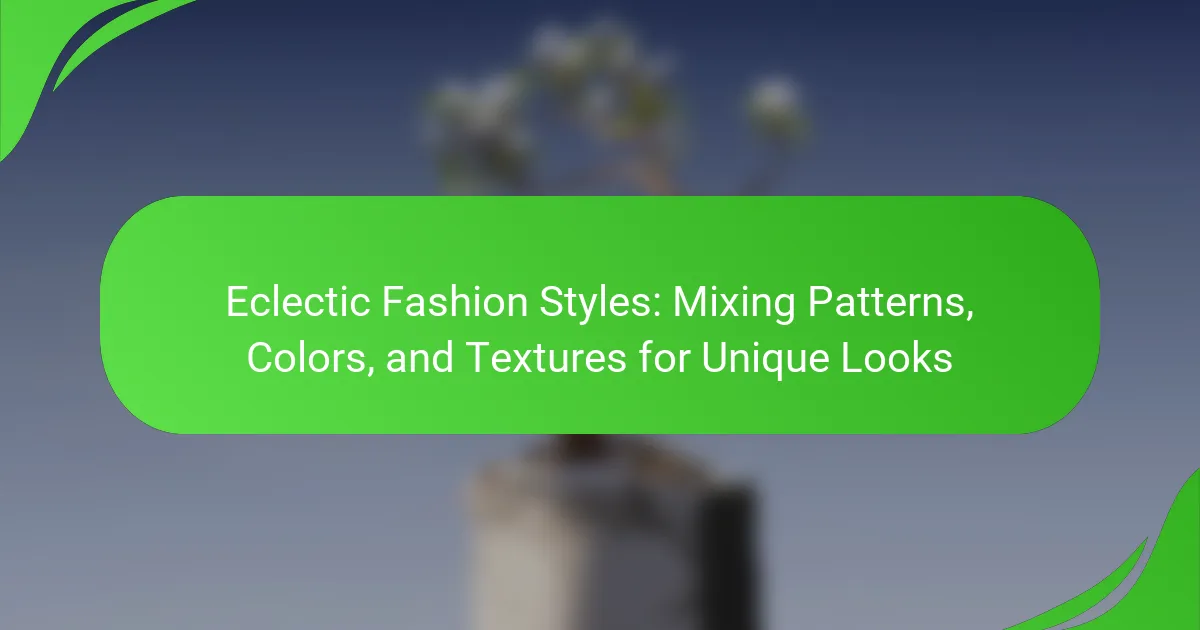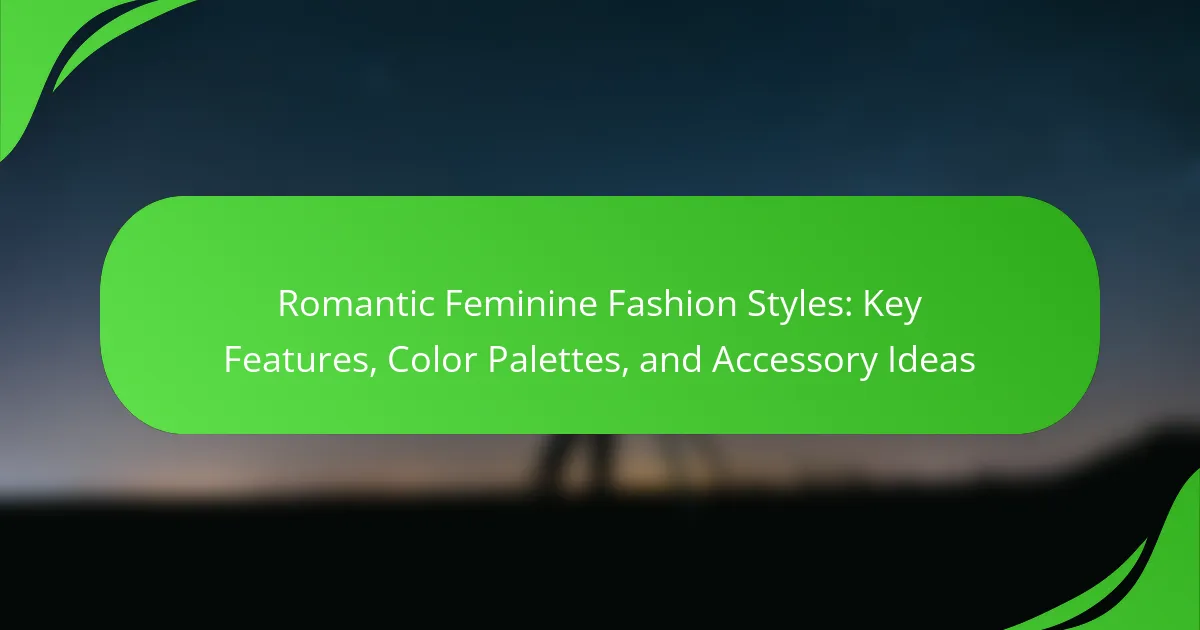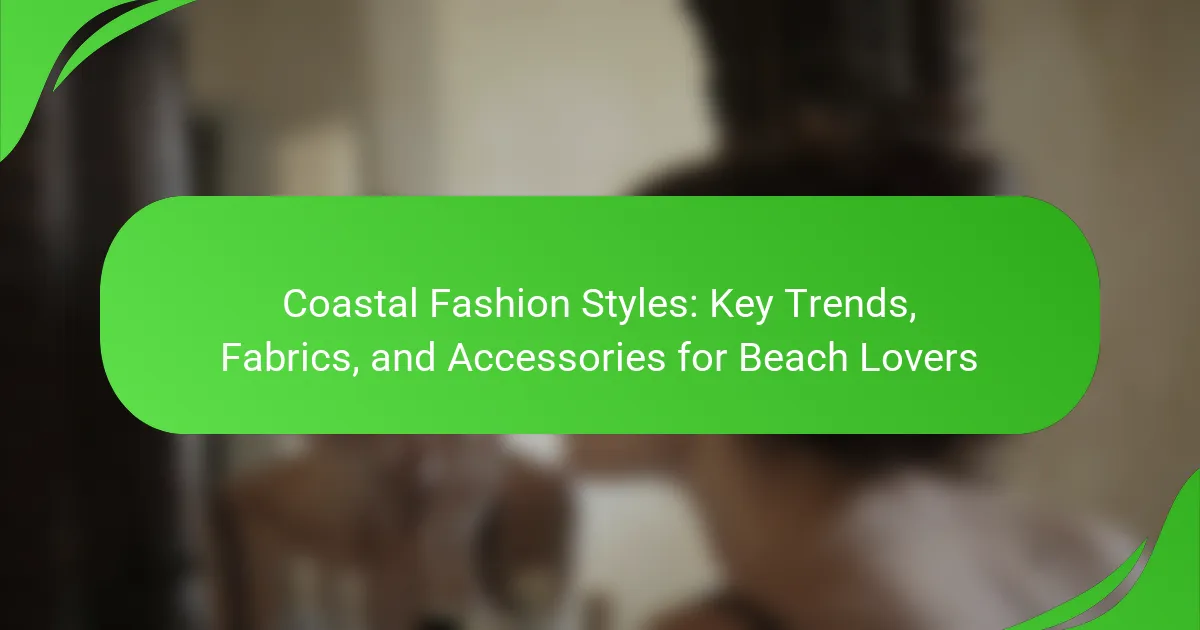Eclectic fashion styles are characterized by a diverse mix of elements from various fashion trends and cultures, allowing individuals to express their unique personality through varied patterns, colors, and textures. This style encourages creativity and personal interpretation, often combining vintage pieces with modern attire while breaking traditional fashion rules. Key aspects include the importance of mixing patterns to create visual interest, enhancing confidence and self-image, and reflecting cultural influences. The article provides practical tips for creating unique looks by layering contrasting pieces, incorporating bold accessories, and experimenting with colors and textures, ultimately fostering individuality and self-expression in personal style.
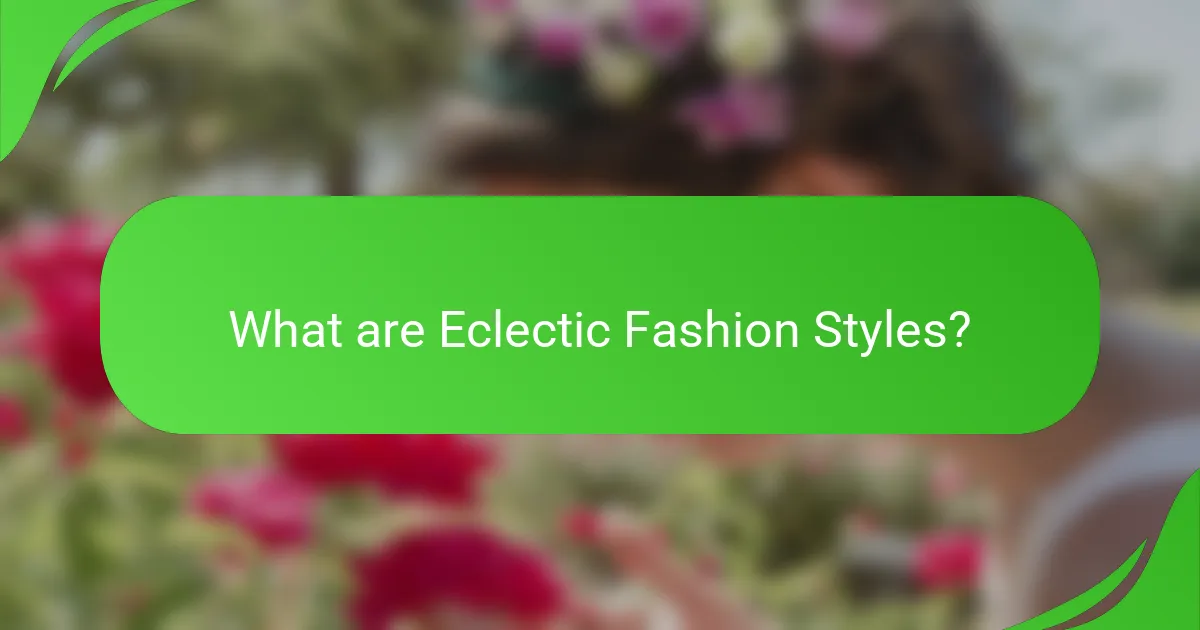
What are Eclectic Fashion Styles?
Eclectic fashion styles are characterized by a diverse mix of elements from various fashion trends and cultures. This style allows individuals to express their unique personality through varied patterns, colors, and textures. Eclectic fashion often combines vintage pieces with modern attire. It encourages creativity and personal interpretation in wardrobe choices. The approach is not limited to one aesthetic; it embraces contradictions and contrasts. This style emphasizes individuality and self-expression. Many fashion influencers and designers promote eclecticism as a way to stand out. Historical movements in fashion have paved the way for this inclusive style.
How do eclectic fashion styles differ from traditional styles?
Eclectic fashion styles differ from traditional styles in their approach to combining diverse influences. Eclectic styles embrace a mix of patterns, colors, and textures from various cultures and eras. Traditional styles typically adhere to established norms and aesthetics. They often reflect specific cultural or historical contexts. Eclectic fashion encourages creativity and individual expression. It allows for personal interpretation and unique combinations. This flexibility contrasts with the rigidity often found in traditional styles. For example, traditional styles might emphasize symmetry and uniformity, while eclectic styles prioritize bold contrasts and unexpected pairings.
What are the key characteristics of eclectic fashion?
Eclectic fashion is characterized by a mix of diverse styles, patterns, and textures. This fashion style embraces individuality and self-expression. It often combines vintage pieces with modern trends. Color palettes can vary widely, showcasing bold contrasts or harmonious blends. Layering different fabrics is common, creating unique visual interest. Accessories play a crucial role, often being statement pieces. Influences can come from various cultures and eras. Eclectic fashion encourages personal creativity and experimentation in outfit choices.
Why is eclectic fashion considered unique?
Eclectic fashion is considered unique because it combines diverse styles, patterns, and influences. This approach allows for personal expression and creativity in wardrobe choices. Unlike traditional fashion, which often adheres to specific trends or aesthetics, eclectic fashion embraces variety. It often includes elements from vintage, modern, and cultural styles. This blend creates distinctive looks that reflect individual personality. The uniqueness is further enhanced by the juxtaposition of colors and textures. Each outfit becomes a personal statement rather than a replication of mainstream trends. This originality is what sets eclectic fashion apart in the fashion landscape.
What are the main components of eclectic fashion?
The main components of eclectic fashion are diverse patterns, vibrant colors, and varied textures. Eclectic fashion embraces individuality and personal expression. It often combines elements from different cultures and eras. This style encourages mixing and matching clothing items creatively. Accessories play a significant role in enhancing eclectic looks. Layering different pieces adds depth to outfits. Footwear choices can range widely, contributing to the overall eclectic vibe. The result is a unique, personalized style that reflects the wearer’s personality.
How do patterns play a role in eclectic fashion?
Patterns are essential in eclectic fashion as they create visual interest and uniqueness. They allow individuals to express personal style by combining various designs. This mixing of patterns can include stripes, florals, and geometric shapes. The juxtaposition of different patterns showcases creativity and individuality. Eclectic fashion encourages experimentation with contrasting styles. For instance, pairing a floral print with stripes can create a bold statement. This approach reflects the wearer’s personality and mood. Historical influences, such as the 1970s bohemian style, emphasize the importance of mixing patterns. Overall, patterns serve as a key element in defining eclectic fashion aesthetics.
What colors are commonly used in eclectic fashion styles?
Eclectic fashion styles commonly use a vibrant mix of colors. Bright hues like red, blue, yellow, and green are frequently seen. Earthy tones such as browns and olives also appear in these styles. Pastels and bold prints can complement the overall look. The combination of these colors creates unique visual contrasts. This style encourages individual expression through diverse color palettes. Fashion designers often experiment with unexpected color pairings. This approach reflects personal style and creativity in fashion.
How do textures enhance eclectic fashion looks?
Textures enhance eclectic fashion looks by adding depth and dimension to outfits. They create visual interest and can transform a simple ensemble into a statement piece. Different textures, such as leather, silk, and knit, can be combined to create contrast. This contrast highlights the individuality of each piece within the outfit. For instance, pairing a rough denim jacket with a smooth satin dress creates a striking juxtaposition. Textures also influence the overall mood of an outfit. A soft cashmere sweater can evoke comfort, while metallic fabrics can suggest boldness. The strategic use of textures allows for personal expression in fashion. Ultimately, textures play a crucial role in defining eclectic fashion aesthetics.
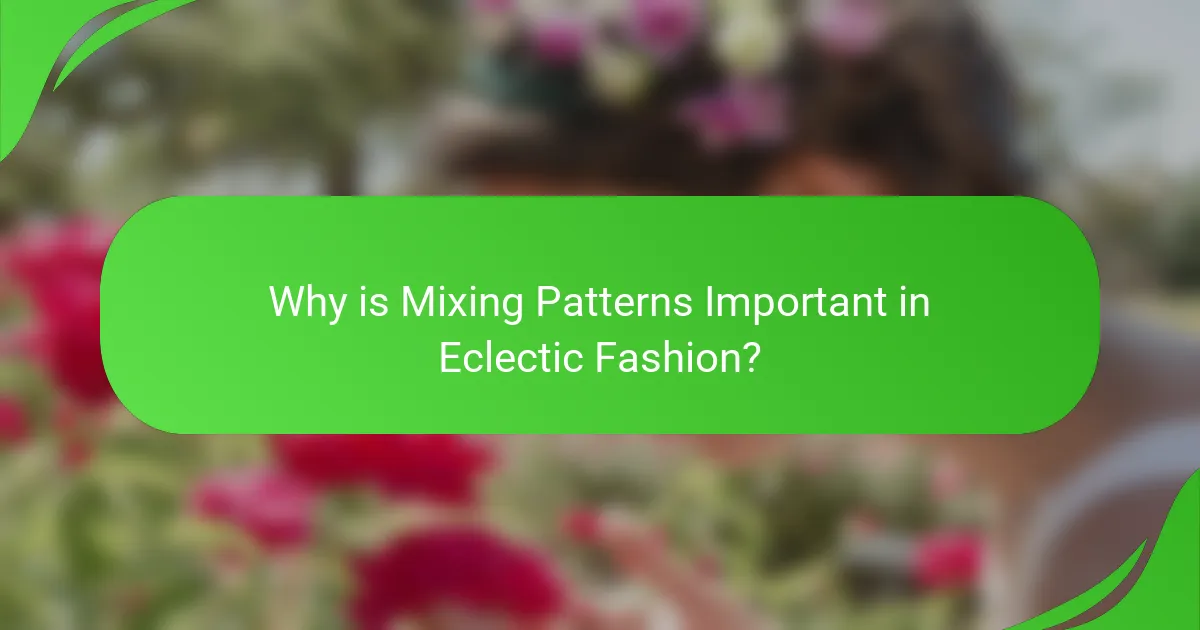
Why is Mixing Patterns Important in Eclectic Fashion?
Mixing patterns is important in eclectic fashion because it creates visual interest and individuality. Eclectic fashion thrives on the combination of diverse styles. This approach allows for personal expression and creativity. It breaks traditional fashion rules, encouraging uniqueness. Studies show that bold pattern mixing can enhance one’s confidence and self-image. Additionally, mixing patterns can reflect cultural influences and personal stories. This method results in outfits that are dynamic and engaging. Ultimately, it fosters a sense of freedom in personal style.
How can one effectively mix patterns in outfits?
To effectively mix patterns in outfits, start with a common color palette. Choose patterns that share at least one color to create cohesion. Next, vary the scale of the patterns. Pair a large print with a smaller one for balance. Incorporate solid colors as anchors. This helps break up the patterns and provides visual rest. Consider the style and vibe of the patterns. Mixing casual with formal can create an interesting contrast. Use accessories to tie the look together. Scarves or bags can incorporate both patterns seamlessly. Lastly, confidence is key. Wearing mixed patterns boldly can enhance your overall style.
What are some popular pattern combinations?
Popular pattern combinations include stripes with florals, polka dots with plaids, and animal prints with geometric designs. Stripes and florals create a balanced yet lively look. Polka dots paired with plaids add a playful contrast. Animal prints combined with geometric patterns introduce an edgy vibe. These combinations are frequently seen in fashion collections and street style. Designers often utilize these pairings to showcase creativity and individuality. Each combination brings a unique aesthetic to eclectic fashion styles.
What tips can help avoid clashing patterns?
To avoid clashing patterns, choose a color palette that unifies different prints. Selecting patterns with at least one common color helps create harmony. Pair large patterns with smaller ones to balance visual weight. Mixing different types of patterns, such as stripes with florals, can work if they share a similar color scheme. Limit the number of patterns to two or three to maintain coherence in the outfit. Use solid colors as a base to ground the look and provide contrast. Consider the scale of patterns; varying sizes can prevent overwhelming the visual space. Lastly, ensure that the patterns reflect a unified theme or style to enhance overall cohesion.
What role do colors play in creating eclectic looks?
Colors are essential in creating eclectic looks as they establish mood and express individuality. They allow for the combination of diverse styles and patterns. Vibrant colors can energize an outfit, while muted tones can add sophistication. The interplay of contrasting colors creates visual interest and depth. Studies show that color combinations can influence perceptions of style. For instance, a bold mix of colors can reflect creativity and confidence. Ultimately, colors serve as foundational elements that unify various fashion components in eclectic styles.
How can color theory be applied to eclectic fashion?
Color theory can be applied to eclectic fashion by using color combinations to create visually striking outfits. Understanding the color wheel helps in selecting complementary and contrasting colors. Complementary colors, found opposite each other on the wheel, enhance each other when paired. For example, a blue dress can be accentuated with orange accessories.
Analogous colors, which are next to each other on the wheel, provide a harmonious look. Using shades of blue, green, and teal together can create a cohesive outfit. Additionally, the use of warm and cool tones can influence the mood of an ensemble. Warm colors like red and yellow evoke energy, while cool colors like blue and green provide calmness.
Color psychology also plays a role in eclectic fashion. Different colors can convey various emotions and messages. For instance, wearing vibrant colors may express confidence and creativity. In contrast, muted tones can suggest sophistication and elegance.
By applying these principles, individuals can mix patterns and textures effectively while maintaining a balanced color palette. This approach allows for personal expression and unique style in eclectic fashion.
What are the best color palettes for eclectic styles?
The best color palettes for eclectic styles often include bold and contrasting colors. These palettes can feature vibrant hues like turquoise, fuchsia, and mustard yellow. They may also incorporate earthy tones such as olive green and terracotta. Additionally, combining neutrals like beige or gray can balance the vibrancy. A popular eclectic palette often mixes jewel tones with pastels for a dynamic look. Patterns and textures can be seamlessly integrated by using colors from the same palette. This approach creates cohesion while allowing for individuality. The effectiveness of these palettes is supported by fashion designers who frequently use them in eclectic collections.
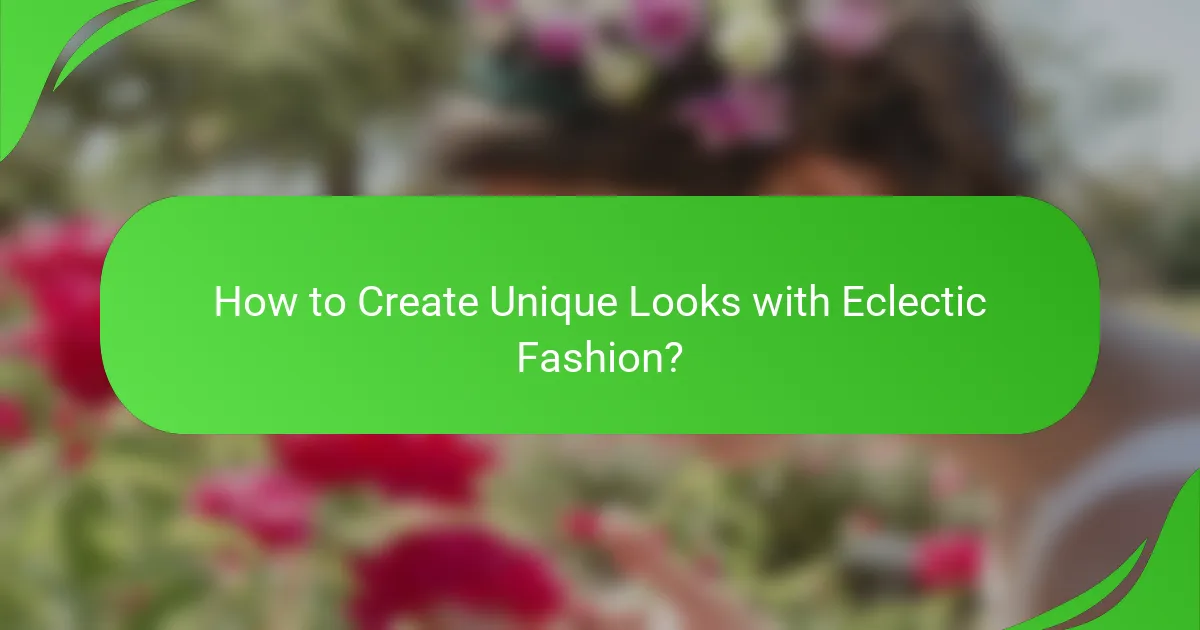
How to Create Unique Looks with Eclectic Fashion?
To create unique looks with eclectic fashion, combine diverse styles, patterns, and textures. Start by selecting a base outfit, such as a neutral dress or tailored pants. Layer with contrasting pieces, like a vintage jacket or a colorful scarf. Incorporate bold accessories, including statement jewelry or unique bags. Mix various patterns, such as stripes with florals or geometric prints. Use different textures, like denim with silk or leather with lace. Experiment with colors by pairing unexpected hues together. This approach allows for personal expression and creativity. Eclectic fashion encourages individuality and showcases personal style.
What are some practical tips for mixing textures?
To mix textures effectively, start by choosing a dominant texture as a foundation. This could be a soft fabric like cotton or a rough material like denim. Next, layer contrasting textures to create visual interest. For example, pair smooth silk with a chunky knit. Use varying scales of texture; large textures can balance smaller ones. Incorporate different materials, such as leather, lace, or wool, for depth. Stick to a cohesive color palette to unify the look. Finally, consider the context of the outfit; casual settings may allow for bolder mixes than formal ones.
How can layering be used to enhance eclectic outfits?
Layering can enhance eclectic outfits by adding depth and visual interest. It allows for the combination of various textures and patterns, creating a unique look. For instance, layering a patterned shirt under a solid jacket can provide contrast. This technique also enables the mixing of different colors, which is essential in eclectic fashion.
Layering can help balance proportions, especially when combining loose and fitted pieces. It can also transition an outfit from day to night by simply adding or removing layers. According to fashion experts, layering is a key strategy in achieving a dynamic and personalized style. This approach encourages creativity and individual expression in fashion choices.
What accessories complement eclectic fashion styles?
Accessories that complement eclectic fashion styles include bold statement jewelry, unique handbags, and vibrant scarves. Statement jewelry can feature oversized earrings or chunky necklaces, adding visual interest. Unique handbags often showcase unconventional shapes or patterns, enhancing the outfit’s overall appeal. Vibrant scarves can introduce color and texture, tying together different elements of an eclectic look. Additionally, hats with distinctive designs or colors can elevate the outfit further. Footwear like colorful boots or patterned sneakers also contributes to the eclectic aesthetic. These accessories allow for personal expression and creativity, aligning with the core principles of eclectic fashion.
What are common mistakes to avoid in eclectic fashion?
Common mistakes to avoid in eclectic fashion include clashing patterns, over-accessorizing, and ignoring color harmony. Clashing patterns can create visual chaos. It is essential to balance patterns for a cohesive look. Over-accessorizing can overwhelm an outfit. A few well-chosen accessories enhance rather than detract. Ignoring color harmony leads to disjointed outfits. Stick to a color palette to unify diverse elements. Additionally, neglecting personal style can result in outfits that feel inauthentic. Embrace individuality while mixing styles. Lastly, failing to consider occasion appropriateness can lead to mismatched outfits. Each outfit should suit the event or setting.
How can one ensure balance in an eclectic outfit?
To ensure balance in an eclectic outfit, focus on creating a cohesive color palette. Choose a few complementary colors to tie different pieces together. Limit the number of patterns to avoid visual chaos. Mixing textures can add depth, but maintain a sense of harmony. Use neutral tones as a base to ground the outfit. Accessories can also help unify the look. Aim for a balanced silhouette by combining fitted and loose pieces. This approach creates a visually appealing and harmonious ensemble.
What should be considered when choosing statement pieces?
When choosing statement pieces, consider the overall aesthetic you want to achieve. Statement pieces should complement your existing wardrobe. Assess the colors and patterns of the statement piece. They should harmonize with other items in your outfit. Evaluate the fit and comfort of the piece. A well-fitting statement piece enhances your confidence. Think about the versatility of the item. It should be suitable for various occasions. Finally, consider your personal style. The statement piece should reflect your individuality and taste.
What are the best practices for embracing eclectic fashion?
Embracing eclectic fashion involves combining various styles, patterns, and textures. Start by identifying your personal style influences. This could include vintage, bohemian, or modern elements. Next, mix different patterns, such as stripes with florals, to create visual interest. Layering is essential; use different textures like denim, silk, and leather for depth. Color coordination enhances the eclectic look; choose a unifying color palette to tie outfits together. Accessories play a crucial role; bold jewelry or unique bags can elevate an outfit. Experimentation is key; try new combinations to discover what works for you. Lastly, confidence is vital; wear your eclectic style with assurance to make a statement.
How can personal style be expressed through eclectic fashion?
Personal style can be expressed through eclectic fashion by combining diverse elements from various styles. This approach allows individuals to showcase their unique preferences and creativity. Eclectic fashion encourages mixing patterns, colors, and textures that may not traditionally go together. For example, pairing vintage pieces with modern accessories creates a distinctive look. Additionally, incorporating cultural influences can enhance personal expression. Wearing bold prints alongside neutral tones can highlight individual taste. Ultimately, eclectic fashion reflects one’s personality and artistic vision.
What resources are available for inspiration in eclectic fashion?
Resources for inspiration in eclectic fashion include fashion blogs, social media platforms, and style magazines. Fashion blogs often showcase diverse styles and unique combinations. Social media platforms like Instagram and Pinterest provide visual inspiration through user-generated content. Style magazines feature curated looks and trend analyses. Online fashion communities allow for sharing ideas and inspiration. Fashion history books can offer insights into past styles and their modern interpretations. Thrift stores and vintage shops serve as treasure troves for unique pieces. Fashion events and runway shows highlight innovative combinations and trends. These resources collectively foster creativity in eclectic fashion.
Eclectic fashion styles are defined by their diverse mix of elements from various trends and cultures, allowing for personal expression through unique combinations of patterns, colors, and textures. This article explores the key characteristics of eclectic fashion, including the importance of mixing patterns, the role of colors and textures, and practical tips for creating standout outfits. It also highlights common mistakes to avoid and best practices for embracing individuality in style. Resources for inspiration and guidance on how to effectively mix different fashion elements are provided, emphasizing the creativity inherent in eclectic fashion.
